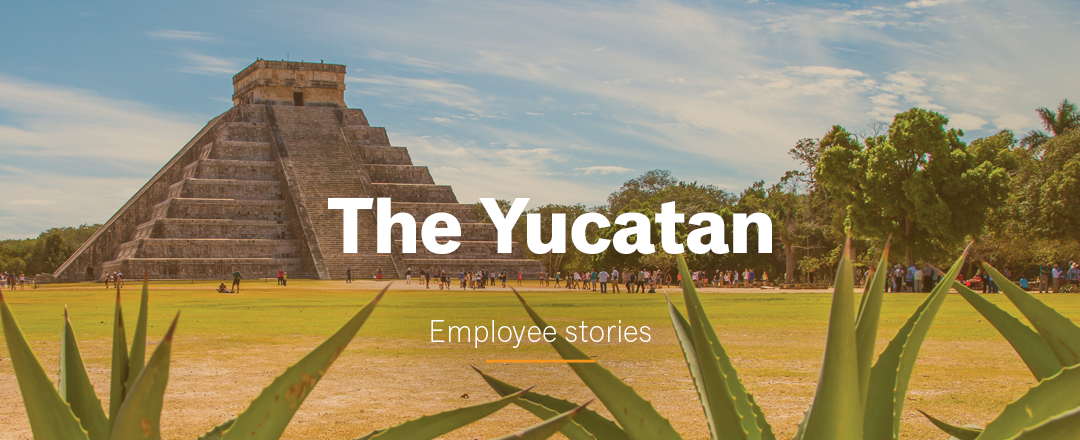My husband and I were looking for a fun winter trip that wouldn’t be too difficult to fit into a week, and the Yucatán Peninsula in Mexico turned out to be the perfect option: with the warm weather, the lack of jetlag, and the short flight times, plus the fact that neither of us had been, it was ideal. Also, we were super interested in seeing a part of Mexico that is off the beaten path, complete with plenty of ruins from the Mayan civilization.
I quickly brushed off my five years’ worth of Spanish education and set up what turned out to be an exciting, but also relaxing, trip. Not fans of resorts or laying out on the beach too much while abroad, we were happy to use Explorica’s Yucatán Adventure itinerary with a couple of omissions and additions. The itinerary was perfect for us: it skips Cancún and went straight to what I think are the more fun parts of traveling, but without sacrificing relaxation.
Traveling in the Yucatán: An inside scoop
Day 1: Valladolid
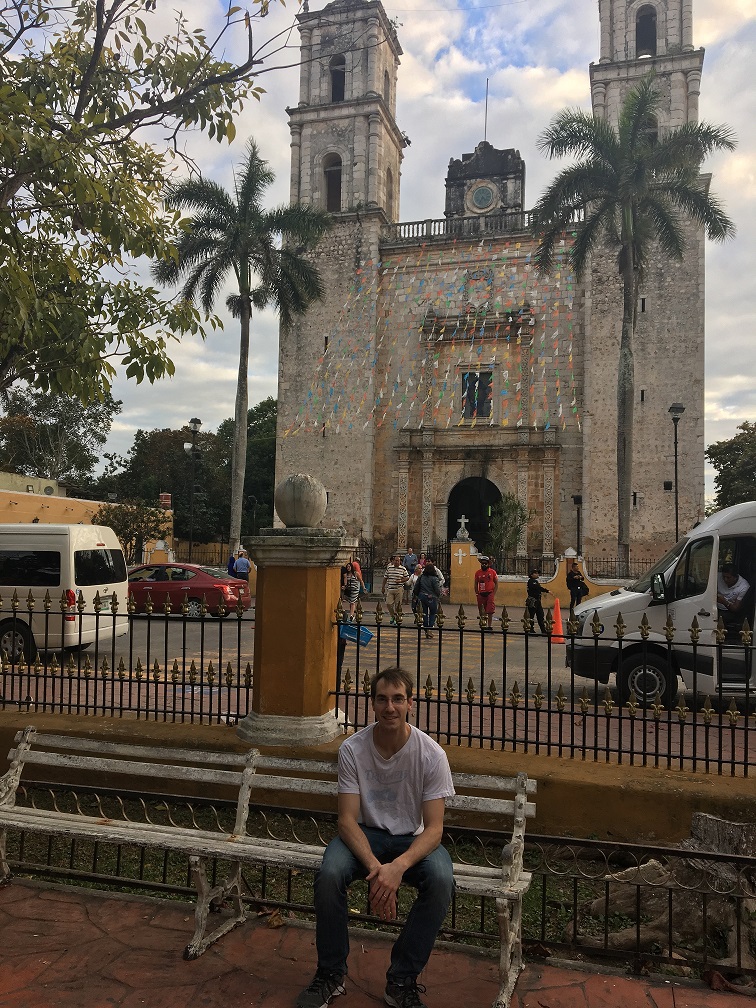
My other half poses in front of the Cathedral of “San Servacio o Gervasio” in Valladolid.
On day one, we arrived in Cancún and rented a car. Luckily, on an Explorica tour you only have to worry about getting on your bus and relaxing after your flight, but you do still get to enjoy long drives on the region’s excellent highway system, which was essentially made for tourists. Getting over our initial fear of driving abroad (refreshingly easy in Mexico), we loved these long stretches that included glimpses of small towns on the outskirts.
After about a two-hour drive, we arrived in Valladolid. A small, cozy town with an easy-to-navigate grid system and pastel-colored architecture, Valladolid is a Spanish colonial town founded in 1543. We took a little walk to the colorful main plaza, complete with fruit and souvenir vendors, and saw the Cathedral of “San Servacio o Gervasio,” which is old, crumbling, and beautiful. Nearby was our first cenote, Cenote Zaci,* a gorgeous cave pool that’s easy (and free) to view. We were pleasantly surprised to find hammocks at our hotel and slept well for a busy Day 2.
Day 2: Valladolid
Our trip began in earnest on Day 2 with a trip to the pre- and post-classical Mayan archaeological site Ek’ Balam. A relatively small site, Ek’ Balam features climbable ruins, which make for a fun adventure.
Since we weren’t on an Explorica tour, we didn’t have a guide to lead us through the structures, though luckily for me, my husband is an archaeologist. He pointed out Mayan hieroglyphs, with letters that intertwine and act as artwork, along with what looked like a massive hill — an anomaly in the flat Mexican landscape, the “hill” was really an overgrown, not-yet-excavated structure.
From there, we drove south past Valladolid to tour sister Cenotes XKeken and Dzitnup. Both cenotes were gorgeous, featuring turquoise water that was lit by a natural skylight, and little catfish** in the water. The cave pool makes for some scary swimming — or so I thought — but it was beautiful, relaxing, and fun. Dzitnup was my personal favorite, as it featured stalactite running down from the ceiling.
Returning to Valladolid, we were pleasantly surprised to find that we arrived just in time for a weekly dance festival. We watched some traditional dancing in the main plaza, pet some horses,** and tried free food. If you happen to be there on a Monday night, check it out.
Day 3: Mérida
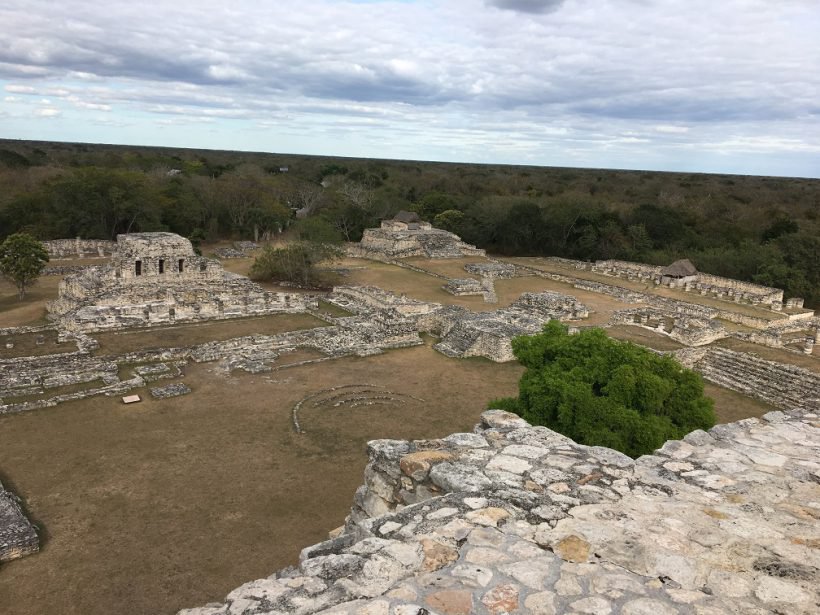
Mayapán, from the top of a structure.
Chichén Itzá is the quintessential monument: An enormous pyramid is the main feature, and the pre-Columbian site is filled with similarly impressive structures. My favorite part was the ball court, essentially a stadium where Mayans would play a game that might remind you of modern-day basketball. While the site was awesome, we were glad to have visited early in the morning, as it filled up with tourists before long. Hundreds of shopkeepers lined the paths of the site as we left.
The nearby Ik Kil Cenote was an incredible site. It featured railings around the skylight so you could look down directly into the pool. Once inside, you can jump in from a balcony. From there, we went for a walk through the Balankanche Caves. Once a water source for nearby Mayans, the cave included Mayan artifacts that were left there, with many surrounding a stalactite formation that resembled a tree. Oh, and we saw bats**!
Our last stop before traveling to Mérida was Mayapán,* another Mayan site. This site was much smaller than Chichén Itzá, but what made it so special was how remote and deserted it was. We were the only people there, and we climbed the ruins and explored them ourselves. It felt as if we had discovered them, and this made it really unique.
Day 4: Mérida
We spent most of Day 4 exploring Mérida, starting in the beautiful Plaza Grande, a huge square surrounded by government buildings and an incredible 16th-century cathedral. Like Valladolid, the colonial city of Mérida is on a grid system, so it was very easy to navigate as we made our way to the Paseo de Montejo. Impressive statues along with the beautiful Palacio Cantón lined the boulevard. And we didn’t forget to stop at Ki’ Xocolatl, a popular chocolate shop in town, and a great place to buy gifts.
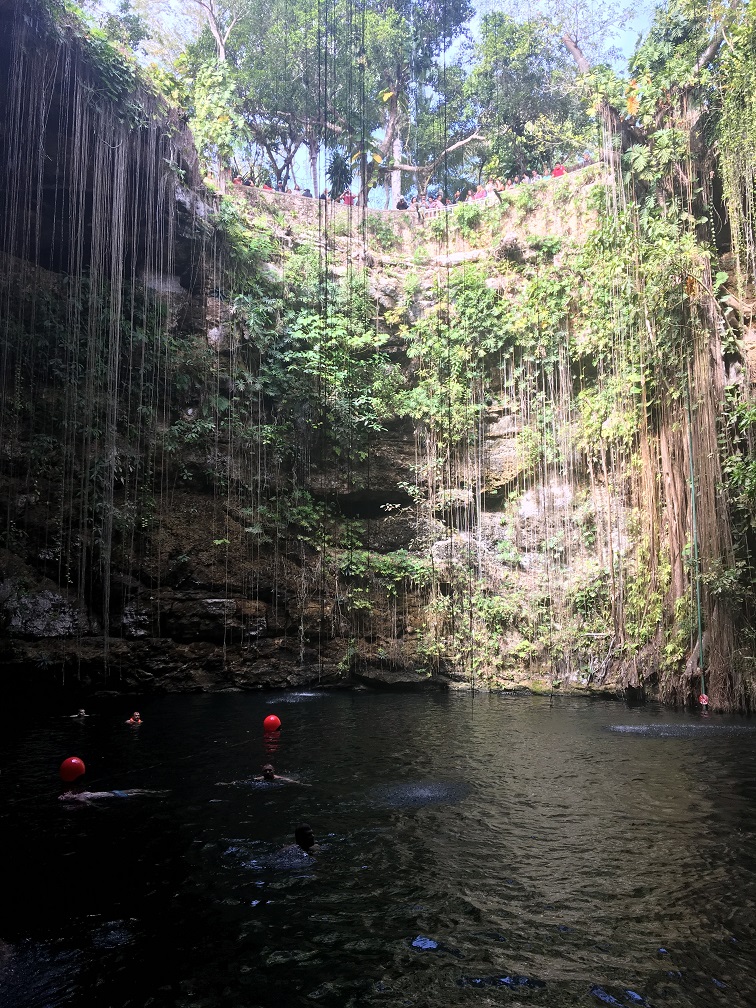
Ik Kil Cenote.
We now turn to perhaps the highlight of the tour, the Chuburná Mangrove sunset kayaking tour. This tour was nothing short of gorgeous. My husband and I got in a shared kayak and were led through the mangroves by two local tour guides who explained why the landscape is so important to the Mayan people. We saw baby flamingos** and went through some mangrove corridors that were difficult to navigate.
Before heading back to shore, we stopped at a sand dune in the middle of the water, tied up our kayaks, and walked on the dune. From afar, it would have looked like we were walking on water. Sidenote: Even though you’re in a boat, you will get wet on this part of the tour. If you have water shoes, those will be good to have. Otherwise you’ll be barefoot, which is fine.
Day 5: Mérida
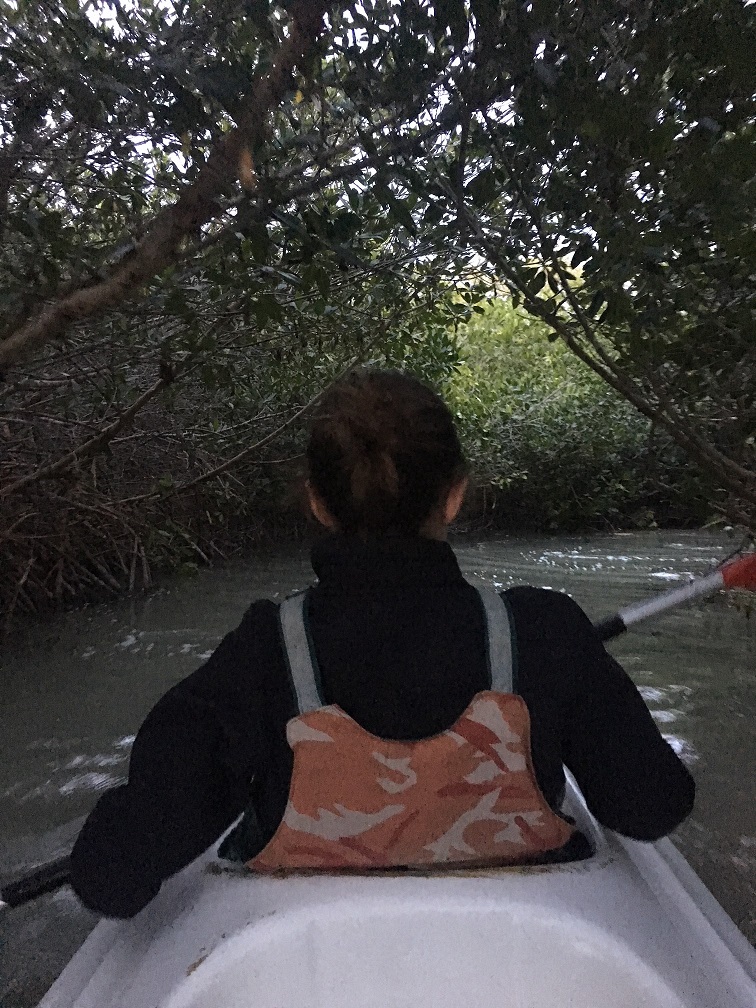
Me, navigating a kayak in the Chuburna Mangrove tour.
Uxmal was another impressive archaeological site featuring massive palaces and lots of huge iguanas.** The Pyramid of the Magician is your first stop at Uxmal, and you may see people outside clapping. That’s because when you clap at the right spot, a chirp echoes back to you. We walked around and climbed some massive palaces and other ruins before heading to Loltun Caves.*
An excellent tour guide named Pablo led us through this incredible cave system, which he actually played in when he was little. The caves, he said, are sacred to the Mayan people, and were considered entrances into the underworld. They were also strategic for defense and gathering water. Cave paintings, including red hand prints, led us to various parts of the cave system, including beautiful cenotes. When Pablo was young, mammoth bones were strewn about near the entrance to the cenote, and he speculated that animals were led there and pushed into the cenote as a hunting strategy.
In probably my favorite interaction with a local the entire trip, my husband and I walked across the street from Loltun, completely parched (we both have an affinity for Japanese-style peanuts and didn’t bring enough bottles), and looking for a place to buy water. We found an old woman in a tiny hut surrounded by chickens, featuring an old hammock and an indoor fire, and, strangely, a vending machine. I couldn’t help but applaud the woman’s business model of selling water to dehydrated tourists in the middle of nowhere.
Day 6: Playa del Carmen
We spent most of the day traveling to Playa del Carmen, and then I spent the rest of the day being just a little bit sick (Don’t drink the water. That includes ice). We were supposed to go to the beach, but took a nice walk through town instead. It’s an incredibly touristy area, but fun to walk through. The beach was beautiful and there were lots of shops, and the pedestrian-friendly streets made for fun people watching.
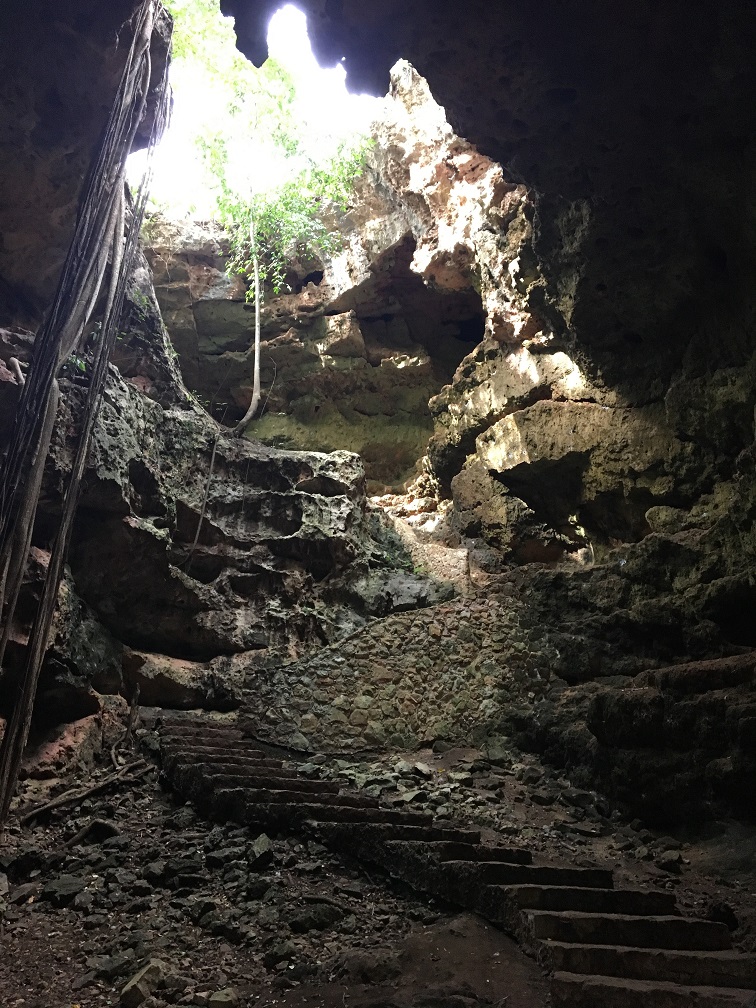
Loltun caves.
Day 7: Playa del Carmen
I was still feeling sick, so we skipped Tulum (sorry) and went to Akumal Bay in the afternoon so I could fulfill my life’s goal of seeing a sea turtle. We rented snorkels and went for a swim, spotting coral and lots of beautiful fish,** but missing the sea turtles.
Don’t worry, though — since we weren’t on a tour, we were restricted to certain parts of the water. With your tour guide and better timing on their part, you’re far more likely to see our favorite shelled friends on your Explorica trip. In any case, the reef was gorgeous, the water was wonderful, and we had a blast.
Day 8: Boston
Back home to feed our guinea pigs.
The basics of traveling in the Yucatán:
Money: While US dollars may be accepted in the more touristy areas like Cancún and Playa del Carmen, the exchange rate for purchases means you’re losing money when you pay with USD. I’d recommend using pesos for the duration of the trip, but especially in less touristy places like Valladolid, where USD are generally not accepted. Try to avoid changing money at the airport, where exchange rates tend to be, well, not as good.
Health and safety: There was never a time when we felt unsafe in Mexico. Locals were extremely friendly and were very welcoming to tourists. If you’re concerned about State Department warnings about Mexico, note that the advisories are state-by-state.
However, please be careful not to drink the tap water, or anything that is washed with water (like fruits with skins) or ice cubes. Peelable fruits like bananas and oranges are okay. One of our hotels had a water cooler for everyone’s use, but for everywhere else we had to buy bottled water. This also applies to brushing your teeth.
One more thing: When snorkeling, be sure to avoid touching coral. Not only is this bad for the coral, but it can also be painful (it leaves a mark!).
Weather: The weather was mild to slightly chilly while we were there (mid-January). Check the forecast online, but it’s pretty consistently beautiful year-round.
Language: If you have any Spanish education, now is the time to use it! Simple vocabulary will get you around fine (asking how much things cost, saying please and thank you, ordering something from a menu), but it’s not completely necessary. Many people speak English, and in general people tried to be accommodating.
*Not on the Explorica itinerary. Talk to your Program Consultant about creating a custom tour that includes this activity!
**Faunal sighting!

